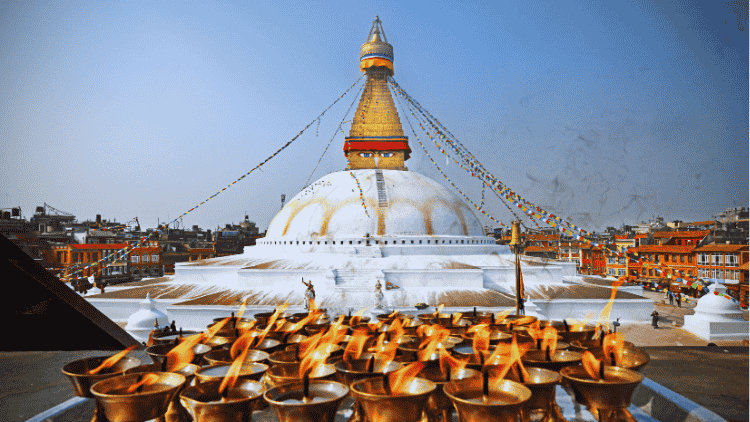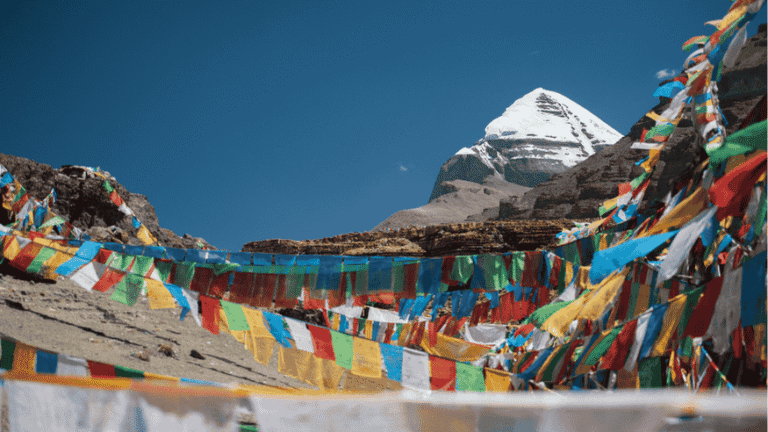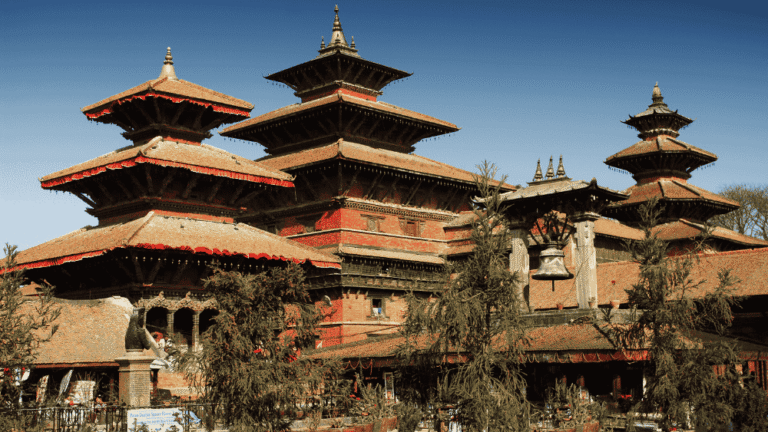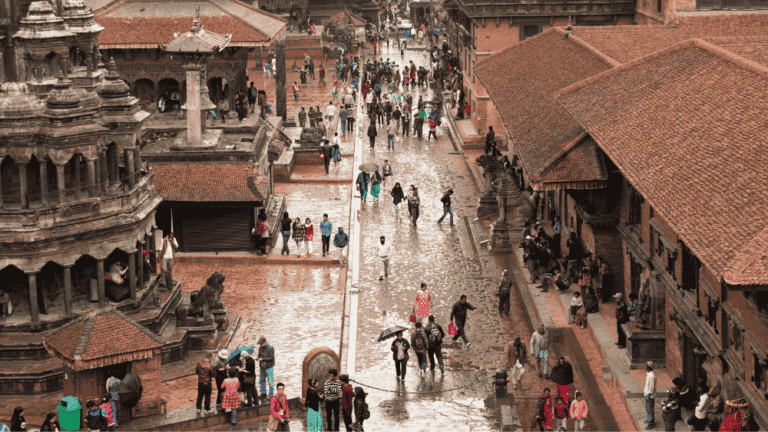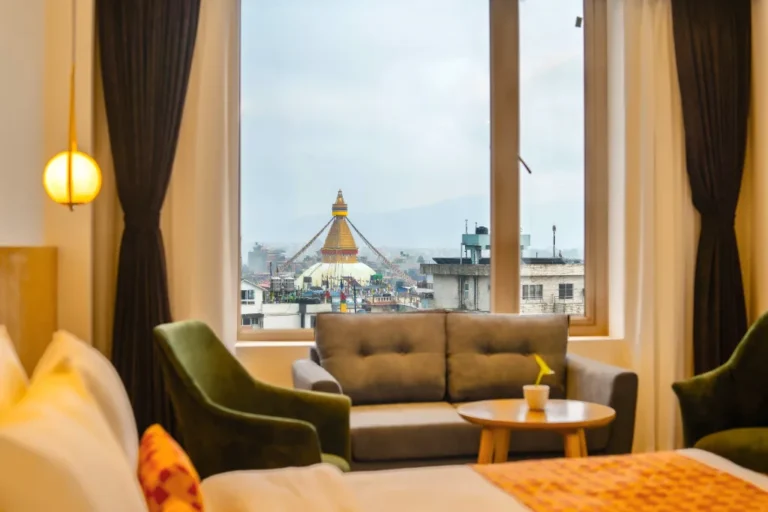Nestled in the heart of Kathmandu, Nepal’s vibrant and energetic capital, lies an iconic place where serenity, history, and culture converge, offering a serene escape from the hustle and bustle of urban life.
It is an awe-inspiring monument, an architectural marvel, a beacon of peace and spirituality, and a renowned UNESCO World Heritage Site.
It is the Boudhanath Stupa—a spiritual sanctuary that captivates the soul.
One of Nepal’s most revered and iconic landmarks, the Boudhanath Stupa (also known as Boudha Stupa) serves not just as a spiritual center for Buddhism but a peaceful escape for travelers and pilgrims alike. Whether you’re a history enthusiast or a passionate traveler, a visit to this Stupa is a must for your trip to Kathmandu.
So in this blog, we’re going to uncover the rich history and spiritual significance of this extraordinary monument. Plus, it is the ultimate guide for travelers who are planning to explore the Boudha Stupa and make their journey unforgettable.
About Boudhanath Stupa
The Boudhanath Stupa, also known as Khāsti Chaitya, is one of the largest and oldest stupas in Nepal. Located in the Kathmandu valley, this stupa is an important pilgrimage site for Nepalese and Tibetan Buddhists.
It is a 118-foot-tall stupa with a massive white dome, hundreds of prayer flags, and a striking mandala design. The stupa’s construction is influenced by the architectural style of the Tibetan Buddhists.
The statues of the two dharmachakras, Seto Machindranath and Saraswati, are placed at the main entrance of this stupa that connects to all four directions. This entrance signifies the spiritual importance of Boudhanath to Buddhism.
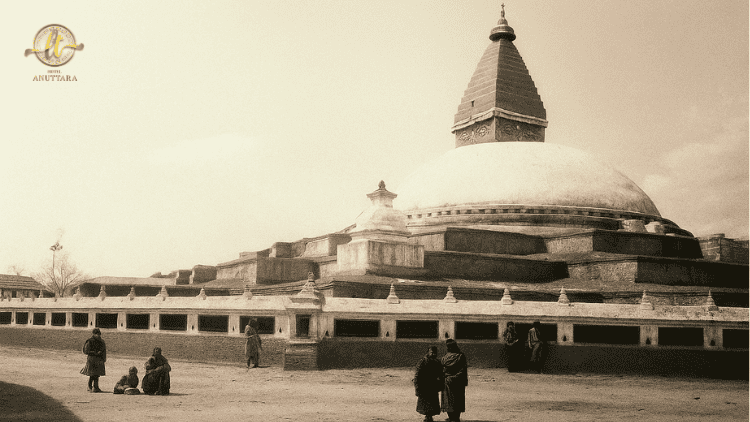
Boudhanath Stupa History
Believed to be built around the 5th century AD by King Manadeva, the Boudhanath Stupa has been a significant Buddhist center for over 1500 years. The stupa has undergone several renovations over the centuries, reflecting its enduring significance in Buddhist culture. The Stupa stands as the symbol of the Buddha’s enlightenment.
1979 is a remarkable year in the Boudhanath Stupa history as it is when the stupa was recognized as a UNESCO World Heritage Site due to its historical, cultural, and religious significance.
This status has helped preserve the stupa and its surrounding areas, ensuring that the rich traditions and architectural marvels remain intact for future generations. The UNESCO designation also underscores the stupa’s role as a symbol of peace and unity, attracting visitors from around the world.
The Spiritual Significance of Boudhanath Stupa Temple
Over several centuries, the Boudhanath Stupa has held a deep religious and cultural significance for the Buddhist religion. It is believed to house the relics of the Buddha, attracting Tibetan Buddhist pilgrims from around the world.
All four sides of the stupa’s tower are painted with eyes, often referred to as the “Eyes of Buddha”, symbolizing the all-seeing nature of the Buddha. These eyes are a reminder of the Buddha’s compassion and omnipresence, watching over the world and guiding believers on the path to enlightenment.
Buddhists mainly visit the Boudhanath Stupa Temple to perform Kora, which is a spiritual practice where one walks around the stupa in a clockwise direction while reciting mantras. You will notice several Buddhist monks circling the stupa, spinning the prayer wheels as they go, and offering prayers for peace and enlightenment.
Best Time to Visit Boudhanath Stupa
While the Boudhanath Stupa can be visited at any time of the year, the ideal period is considered during the Spring (March to May) and Autumn (September to November) seasons. These seasons offer mild weather and clear skies, perfect for exploring the stupa and capturing breathtaking photographs. Early mornings and late nights provide a serene atmosphere with soft, golden lighting.
If you are looking for a unique religious and cultural experience, you can plan your visit during the Buddha Jayanti or Lhosar (the Tibetan New Year), which falls in the Spring season. It is the time when the stupa comes alive with vibrant celebrations, rituals, and prayers.
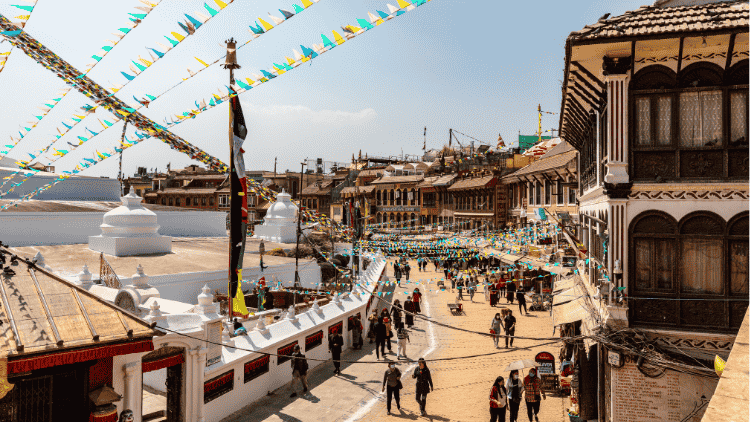
Things to Do Near Boudhanath Stupa
A great thing about Boudhanath Stupa is that it is not only a place of spiritual significance, but it’s also a large cultural hub for Nepalese and Tibetan locals. As a traveler, there are a lot of fun things you can do around the stupa. From visiting beautiful monasteries to exploring small shops, there is something for everyone.
Whether you are looking for peace, culture, or a little adventure, Boudhanath Stupa has many experiences to offer. Here’s what you can do during your visit to the Boudhanath Stupa;
Visit Nearby Monasteries
Due to its spiritual and cultural significance, the Boudhanath Stupa is surrounded by several Tibetan Buddhist monasteries. These monasteries are generally open for visitors, and some of them also offer meditation sessions for a peaceful experience.
Check out Local Shops
The vibrant market around the Boudha Stupa is filled with small shops, run by Tibetan and Nepalese locals selling several interesting items. You can find colorful prayer flags, handmade Tibetan jewelry, Buddhist statues, and more. Buying from these shops is a good way to support the local community.
Explore Nearby Tourist Places
Being located in the central region of the city, the Boudha Stupa is close to various attractive tourist places in Kathmandu. While being here, you can easily visit different tourist attractions, local places, popular restaurants, and more just by traveling for a few minutes.
Taste the Local Cuisine
If you are looking to feast on some local delicacies and try delicious street food, the numerous small restaurants, cafes and rooftop restaurants around the stupa are a blessing for you. You will find several Tibetan and Nepalese dishes, such as dumplings, thukpa, and more.
Experience the Spiritual Atmosphere
Many explorers and wanderers visit Boudhanath just to enjoy the calming, serene, and spiritual atmosphere of this place. You can simply watch monks walk around the stupa, spinning prayer wheels and chanting, creating a unique ambiance.
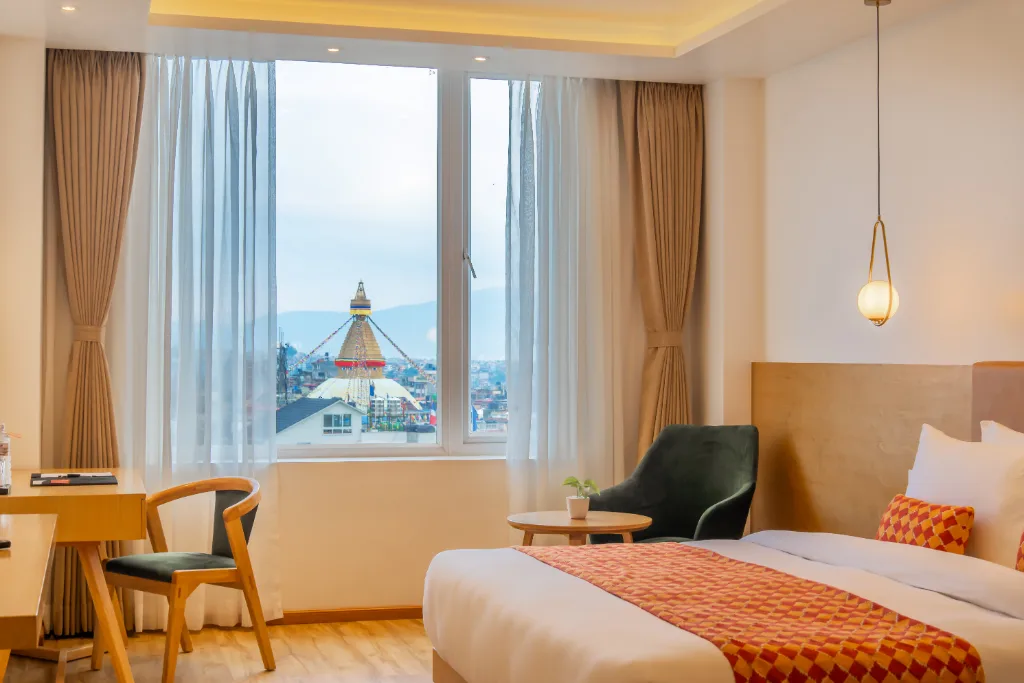
Where to Stay Around Boudhanath Stupa?
The Boudhnath Stupa is more than just a famous landmark; it is a place of deep spiritual meaning, peaceful atmosphere, and cultural richness. Whether you visit to learn about its history, experience Buddhist traditions, or simply enjoy the beauty of the stupa, there is something special for everyone.
There’s no doubt that the Boudha Stupa is one of the most iconic tourist places in Kathmandu, and staying near this place can make your journey unforgettable.
Hotel Anuttara, the most luxurious hotel near Boudhanath Stupa, makes your experience more relaxing and peaceful by offering the best accommodation options and a deep sense of connection with Nepal’s cultural heritage.

